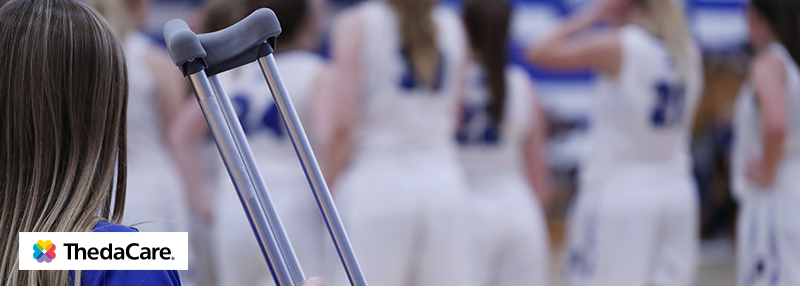
Whether you’re sprinting down the soccer field, diving for a volleyball, or grinding through intense training sessions, student athletes constantly push their bodies to the limit. But with that drive comes a real risk of injury. The good news? Many sports injuries are preventable, and if they do occur, the right recovery tools can get you back in the game faster and stronger.
This guide will walk you through how to prevent common injuries in youth sports and recover effectively using equipment available from ThedaCare at Home.
Injury Prevention Tips for Student Athletes
Injury prevention starts with smart habits and the right gear. These tips can help keep athletes safe throughout the season.
1. Warm Up and Cool Down
Start every practice or game with dynamic stretching and light cardio to activate your muscles and increase circulation. After the activity, cool down with static stretches to improve flexibility, reduce muscle soreness, and support long-term joint health.
2. Strengthen Supporting Muscles
Injuries often happen due to imbalances or weaknesses in stabilizing muscles. Incorporate exercises targeting the core, hips, and shoulders into your strength training to enhance balance, posture, and injury resistance.
3. Use Proper Technique
Whether you’re lifting weights or perfecting your jump shot, form matters. Poor technique increases your risk of overuse injuries or sudden trauma. Coaches, trainers, and physical therapists can help ensure you’re moving correctly.
4. Wear the Right Gear
High-quality shoes, helmets, and padding are essential, but braces and supports for vulnerable joints can be just as important, especially if you’ve had past injuries or are returning to play after a strain or sprain.
Common Sports Injuries in Student Athletes
Adding sport-specific injury awareness can help athletes take preventative measures:
- Ankle sprains in soccer, basketball, and football
- Knee injuries (like ACL tears) in football and gymnastics
- Shin splints in runners and track athletes
- Tennis elbow or wrist strain in racquet sports and weightlifting
- Shoulder overuse injuries in swimmers, pitchers, and volleyball players
- Lower back strain in sports involving twisting or repetitive motion
Recommended Injury Prevention Gear from ThedaCare At Home
Supportive equipment can reduce the risk of injury and keep athletes active throughout the season:
- Aircast® A60 Ankle Support – Ideal for preventing ankle sprains during high-impact sports.
- Elastic Knee Support – Provides light compression and stability during training or early recovery.
- Tennis Elbow Brace – Reduces strain on tendons for athletes in racquet sports, baseball, or weight training.
- Prolite® Wrist Splint – Stabilizes the wrist for gymnasts, lifters, or anyone experiencing repetitive motion strain.
Explore more orthopedic supports and braces to find what’s right for your sport.
Browse Orthopedic Supports & Braces
Recovery After Injury: What to Do and What to Use
Even with smart prevention strategies, injuries can happen. Proper recovery is essential for long-term performance and health.
1. Rest and Protect the Area
Avoid any activity that worsens the injury. Use braces or immobilizers to support and protect the area during healing.
2. I.C.E. – Ice, Compression, and Elevation
Reduce swelling and pain with cold packs, compression sleeves, and elevation. Applying this method within the first 24–72 hours is most effective.
3. Gradual Return to Activity
Work with your physical therapist or athletic trainer to safely reintroduce movement and rebuild strength. Supportive gear can help prevent re-injury during this phase.
Recovery Equipment Available from ThedaCare at Home:
Support your healing journey with equipment designed for student athletes:
- Reaction Web® Knee Brace – Offers dynamic support for ACL or meniscus injury recovery.
- MaxTrax™ ROM Air Walker – Immobilizes foot or ankle injuries while allowing gradual return to mobility.
- Sacro-Lumbar Support – Eases lower back strain from overuse or poor lifting mechanics.
- Safe-T-Sport® Neoprene Shoulder Support – Stabilizes the shoulder after rotator cuff injuries or dislocations.
Also consider cold therapy products or compression garments to aid in swelling control and comfort.
Not Sure What Your Student Needs? Contact Us
For Parents and Coaches: Supporting Student Athletes
Parents, guardians, and coaches play a key role in keeping student athletes healthy. Here’s how you can help:
- Encourage open communication about pain or discomfort before it becomes a bigger issue
- Ensure athletes have adequate rest between practices and games
- Monitor proper technique and promote recovery as seriously as performance
- Help choose appropriate gear and support equipment for their needs
FAQs About Injury Recovery and Prevention
When should a student athlete wear a brace?
Braces are recommended during recovery, when returning to sport after injury, or for ongoing support in vulnerable joints.
How long should rest last after a sports injury?
It depends on the severity. Minor injuries may heal in a few days, while others may need weeks. Follow your healthcare provider’s advice and listen to your body.
What type of brace is best for ankle injuries?
Look for braces like the Aircast A60, which provide stability without restricting movement, ideal for returning to play.
Stay in the Game with ThedaCare At Home
Injuries don’t have to sideline your season. With smart training habits, preventative support gear, and proper recovery tools, you can bounce back stronger and more confident.
Explore the full range of braces and recovery tools at ThedaCare At Home or contact our team for help choosing the right solution. Not sure what you need? Reach out to one of our experts.
Braces and Supports Exercise General Health
August 25, 2025 by ThedaCare At Home

